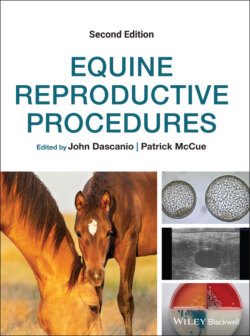Читать книгу Equine Reproductive Procedures - Группа авторов - Страница 74
Оглавление23 Endocrinological Examination
Patrick M. McCue
Equine Reproduction Laboratory, Colorado State University, USA
Introduction
Analysis of reproductive hormones in the non‐pregnant mare is most commonly performed to stage the estrous cycle, evaluate corpus luteum function, and to diagnose ovarian abnormalities. Endocrine tests available for the analysis of clinical samples that may be valuable in equine practice include progesterone, inhibin, testosterone, anti‐Mullerian hormone, total estrogens, conjugated estrogens, adrenocorticotrophic hormone (ACTH), and cortisol. Additional tests that may be available in specialized laboratories include equine chorionic gonadotropin, follicle‐stimulating hormone, luteinizing hormone, prolactin, and relaxin.
Traditionally, blood samples and either serum or plasma samples are collected and submitted to a diagnostic laboratory for analysis. In some instances, such as wild or feral equids, endocrine analysis of urine or feces may be necessary to provide a diagnosis.
Equipment and Supplies
Vacutainer® tubes (10 ml): serum (red top tube without anticoagulant), plasma (green top tube with heparin); Vacutainer® needles, Vacutainer® needle guide, centrifuge, disposable pipettes.
Technique
Collection of one blood sample is generally sufficient. However, because of potential variability in hormone levels in individual animals, the submission of paired samples collected at different times of the day or on subsequent days may be beneficial.
Blood collected in a Vacutainer® tube without anticoagulant should be allowed to clot for 30 minutes. The tube should be centrifuged at 1500–1800× g and the serum aspirated with a disposable pipette and placed into a separate sterile tube for storage or shipment to an endocrine laboratory.
Blood collected in a Vacutainer® tube containing an anticoagulant may be centrifuged immediately and the plasma subsequently transferred into a separate sterile tube using a disposable pipette.
Interpretation
Progesterone concentrations of <0.25 ng/ml indicate an absence of luteal tissue, while concentrations >1 ng/ml indicate the presence of an active corpus luteum.
A progesterone level between 0.25 and 1.0 ng/ml indicates the presence of a limited amount of active luteal tissue. This may be sufficient to keep a mare out of heat or keep edema from forming within endometrial tissue.
Testosterone levels range between 20 and 45 pg/ml in the non‐pregnant mare. Levels are higher in estrus and parallel levels of estradiol‐17β. Approximately 50–60% of mares with ovarian granulosa/theca cell tumors have elevated concentrations of testosterone and affected mares usually exhibit aggressive or stallion‐like behavior. The specific tumor type in these mares is a granulosa/theca cell tumor and the testosterone is produced by the theca cells. Mares with a granulosa cell tumor without a theca cell component will have low testosterone levels.
Inhibin levels range from 2 to 60 pg/ml in the non‐pregnant mare. Concentrations are highest in estrus and decline rapidly after ovulation. Inhibin is elevated in approximately 90% of mares with granulosa cell tumors.
A diagnostic panel consisting of inhibin, testosterone, and progesterone is commonly used to detect the presence, or suggest the absence, of an ovarian granulosa cell tumor (Table 23.1). Elevation in progesterone indicates the presence of luteal tissue and suggests that a tumor is not likely to be present.
Equine chorionic gonadotropin levels may be evaluated to determine pregnancy status or determine the presence or absence of retained endometrial cups in non‐pregnant mares. Mares may exhibit abnormal estrous cycles and repeated cycles with hemorrhagic or luteinized anovulatory follicles.
Anti‐Müllerian hormone (AMH) testing is performed primarily to detect the presence of granulosa cell tumors of the ovary. The concentration of AMH in a mare with a granulosa cell tumor is higher than that in normal mares. The sensitivity of an elevated AMH level for the presence of a granulosa cell tumor has been reported to be 98%.
Another potential use for an AMH test could be to determine the presence or absence of ovaries in a mare. AMH levels should be at baseline concentrations in an ovariectomized mare, but would be detectable in an intact mare.
ACTH and cortisol levels may be useful in evaluating mares suspected of pituitary pars intermedia dysfunction (PPID) or equine Cushing’s disease. Concentrations of ACTH and cortisol are commonly elevated in mares with PPID. A dexamethasone suppression test is considered the gold standard for PPID diagnosis. Affected mares may exhibit failure of follicular development, ovulation failure, or reduced fertility.
Table 23.1 Granulosa cell tumor (GCT) diagnostic panel of hormone reference ranges. Note that reference ranges from individual laboratories may vary slightly.
| Hormone | Normal Range | % Elevated in Mares with GCTs |
|---|---|---|
| Anti‐Müllerian hormone | 0.1–6.9 ng/ml | 98% |
| Inhibin | 2–60 pg/ml | 90% |
| Testosterone | 20–45 pg/ml | 50–60% |
| Progesterone | <1.0 ng/ml in estrus or anestrus >1.0 ng/ml in diestrus or pregnancy | <1% |
Further Reading
1 Almeida J, Ball BA, Conley AJ, et al. 2011. Biological and clinical significance of anti‐Mullerian hormone determination in blood serum of the mare. Theriogenology 76: 1393–403.
2 Anderson RA, Nelson SM, Wallace WHB. 2012. Measuring anti‐Müllerian hormone for the assessment of ovarian reserve: when and for whom is it indicated? Maturitas 71: 28–33.
3 McCue PM, Roser JF, Munro CJ, et al. 2006. Granulosa cell tumors of the equine ovary. Vet Clin North Am Eq Pract 22: 799–817.
